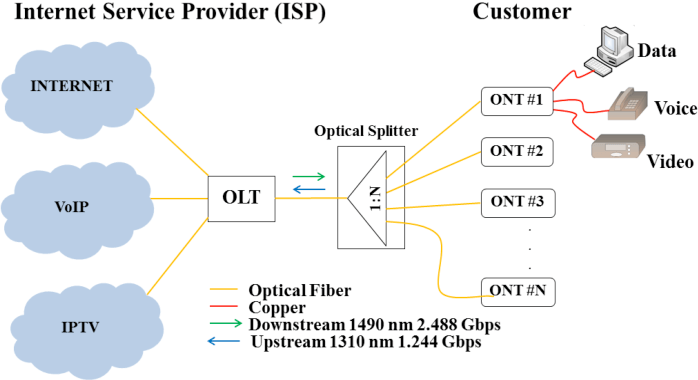In layman’s terms, the integration of Triple-play Network means that the three major networks of telecommunication network, computer network and cable TV network can provide comprehensive multimedia communication services including voice, data and images through technological transformation. Sanhe is a broad and social term. At the present stage, it refers to the “point” in broadcast transmission to “face”, the “point” in communication transmission to “point”, and the computer The time-shifting integration of storage in the network to better serve human beings does not mean the physical integration of the three major networks of telecommunication networks, computer networks, and cable television networks, but mainly refers to the integration of high-level business applications. After the “integration of Triple-play Network”, people can use the TV remote control to make calls, watch TV dramas on their mobile phones, select networks and terminals as needed, and complete communication, TV, and Internet access by simply pulling a line or wireless access.
Three Ladders of FTTx Development
The development of China’s FTTx has gone through three stages. The first stage is from 2005 to 2007. This stage belongs to the experimental stage. In 2005, China Telecom started EPON fiber-to-the-home trials in Beijing, Guangzhou, Shanghai, and Wuhan to verify the maturity of the EPON system and explore construction experience. During this period, China Netcom, China Mobile, etc. have carried out tests and pilot applications on the PON system. The construction scale of FTTx at this stage is very small.
The second phase is from 2008 to 2009, which is a large-scale deployment phase. After the first phase of pilot and research. China Telecom has recognized the maturity and performance of the EPON system, and at the same time explored a set of FTTx construction models, and the construction models of FTTH/FTTB+LAN/FTTB+DSL have been established. More importantly, due to the high price of copper cables at that time, the cost of the FTTB construction model had a greater advantage over the construction cost of laying copper cables. The bandwidth and scalability of the FTTB network were better than that of the copper cable access network. Therefore, at the end of 2007, China Telecom decided to adopt FTTB+LAN for large-scale deployment in newly built areas of the city, carry out FTTB+DSL optical input and copper output transformation in existing areas, and completely stop the laying of new copper cable networks. At this stage, the large-scale deployment of FTTB is due to better cost performance.
The third stage began in 2010, and FTTx entered a new stage of development. At the beginning of 2010, Premier Wen Jiabao of the State Council presided over an executive meeting of the State Council and decided to speed up the integration of the telecommunications network, the radio and television network and the Internet. It is required to speed up the construction of fiber-optic broadband access network and the two-way transformation of radio and television networks, and that telecommunications and radio and television should open their markets to each other and compete reasonably. “Triple play integration” has introduced new competitors and new competitive fields to the entire telecom industry.
In April, 7 ministries and commissions including the Ministry of Industry and Information Technology and the National Development and Reform Commission jointly issued the “Opinions on Promoting the Construction of Optical Fiber Broadband Networks”, requiring telecom operators to accelerate the construction of optical fiber broadband, and speed up the implementation of fiber optic broadband in cities and villages in rural areas. The “Opinions” propose that by 2011, the number of optical fiber broadband ports will exceed 80 million, the average access capacity of urban users will reach more than 8 Mbit/s, the average access capacity of rural users will reach more than 2 Mbit/s, and the average access capacity of commercial building users will basically achieve more than 100 Mbit/s. input ability. Within 3 years, the investment in fiber optic broadband network construction will exceed 150 billion yuan, and the number of new broadband users will exceed 50 million.
Combined with the NGB construction plan released earlier by the State Administration of Radio, Film and Television, the access bandwidth of each household is required to reach 40Mbit/s. The competition introduced by “triple play” has gradually focused on the competition of access bandwidth. Telecom operators and radio and television operators have unanimously adopted FTTx as the preferred technology for high-speed access network construction. This makes the development of FTTx change from a cost factor to a market competition factor. The development of FTTx has entered a new stage.
From another point of view, it is precisely because of the large-scale and mature deployment of FTTx in China that the country believes that from the perspective of technology and industrial chain, there is a technical and material basis for accelerating the “triple network integration”. Based on the need to expand domestic demand and enhance the level of my country’s information technology, the country launched the national strategy of “integration of Triple-play Network” in due course. It can be said that there is a closely interdependent relationship between the development of China’s FTTx industry and the national strategy of “integration of Triple-play Network”.
“Triple play” triggers FTTx development ideas innovation
Fiber-to-the-x (FTTx) fiber access (FTTx, x = H for home, P for premises, C for curb and N for node or neighborhood) where FTTH fiber to the home, FTTP fiber to the premise, FTTC fiber to the Roadside/community, FTTN fiber to the node. Fiber-to-the-home (FTTH) has been a dream and a technology direction that people have been pursuing for 20 years, but due to obstacles in cost, technology, and demand, it has not yet been widely promoted and developed. However, this slow pace of progress has recently changed considerably. Due to policy support and technological development, FTTH has once again become a hot spot after many years of silence, entering a period of rapid development. The comfort and convenience of life brought by various related broadband applications such as VoIP, Online-game, E-learning, MOD (Multimedia on Demand) and smart home, and the interactive high-definition viewing caused by HDTV The revolution has made optical fiber with excellent characteristics such as high bandwidth, large capacity, and low loss an inevitable choice for the medium that transmits data to the client. Because of this, many insightful people regard FTTx (especially fiber-to-the-home and fiber-to-the-premises) as an important turning point in the recovery of the optical communication market. And it is expected that in the next few years, FTTH network will have greater development.
China Telecom plans to build 1 million FTTH networks in 2010. Beijing, Shanghai, Jiangsu, Zhejiang, Guangdong, Wuhan and other provinces and cities have also successively proposed high-speed broadband services such as 20Mbit/s access. It can be predicted that the FTTH (fiber-to-the-home) construction mode will become the mainstream FTTx construction mode from 2011 onwards. The scale of the FTTx industry will also expand accordingly. For radio and television operators, after the “three-network integration”, how to quickly carry out two-way transformation of the existing network and develop new services such as interactive TV, broadband Internet access, and voice access is a top priority. However, due to the lack of funds, technology, and talents, it is impossible to spend a lot of money to build a high-quality telecommunications network. We can only use existing network resources, tap potentials, and build gradually.
Post time: Jun-27-2023



